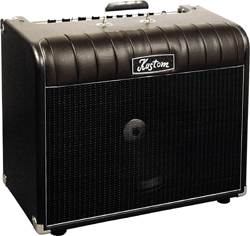Kustom Amps '36 Coupe and '72 Coupe Combos


Ever since their introduction in 1966, Kustom amps have appealed to players with the So-Cal styling of their upholstered “Tuck & Roll” Naugahyde exteriors and the raw beauty of their kick-ass tones. Although these wild amps fell out of favor in recent decades, I’m pleased to see that top players are rediscovering the unique performance that only a Kustom amp can deliver. In particular, the new all-tube Kustom ’36 Coupe and ’72 Coupe combos are continuing the company’s heritage of attention-getting looks and propelling the company forward with soul-stirring boutique tones.
Features The original Kustom amps were wrapped in the company’s trademark padded Tuck & Roll. On the Coupe amps, that vintage styling is recalled with a single panel of the cushioned covering that accents the Tolexcovered cabinet. It’s a nice touch that blends well with the Coupes’ otherwise refined appearance. Although my test amps were wrapped in basic black Tolex, Kustom offers a range of hot solid and sparkle colors.
The ’36 and ’72 Coupe amps are built in Cincinnati, Ohio, using U.S. and imported parts. The ’36 Coupe produces an appropriate 36 watts from its two 6L6 tubes, while the ’72 Coupe utilizes a second pair of 6L6s to generate 72 watts of total power. In each model, the power tubes are housed in a protective mesh cage. Likewise, each amp uses four 12AX7 tubes in the preamp section.
Featurewise, both amps are essentially identical. Each has a two-channel (Rhythm and Lead) design that includes dual inputs, volume and master controls for each channel, a pull-bright function on the volume knobs and a three-band EQ that’s shared by both channels. Furthermore, each amp houses an Accutronics reverb tank and provides a reverb level and reverb tone control, but the ’72 Coupe also has tremolo and vibrato circuits with dedicated level knobs and a master speed dial.
Even on the backside, these amps have nearly identical feature sets that include an all-tube effect loop, a direct XLR output that features speaker-emulation circuitry and a recessed level control, and a recessed pot that controls the level of volume boost available on the included three-button footswitch. In addition to the boost function, the footswitch lets you switch silently between channels and turn the onboard effects on and off. Unique to the ’72, a tiny switch on the back of the amp assigns either the reverb or the vibrato/ tremolo circuits to be footswitchable.
Twelve-inch KEI speakers are used in both amps: one in the ’36 and two in the ’72. Specially designed in conjunction with Eminence, the speakers deliver a perfect mix of punch and complexity.
Performance Judging by the Coupes’ retro looks, I expected them to approximate the punchy and sparkling tone of their late-Sixties predecessors. It was a fair assumption and one that turned out to be correct. Still, I never imagined that the Coupes were also capable of medium- and high-gain textures that compete well with tones from amps that cost three times more.
All the latest guitar news, interviews, lessons, reviews, deals and more, direct to your inbox!
I quickly found the classic punchy Kustom tone in the Rhythm channel by using low volume settings, turning the master past five and activating the bright function. Playing through the channel with my ’60s Strat Relic, these settings let me relive the vintage Kustom tone: slightly crunchy notes with a singular focus bloomed and dissipated, leaving glistening overtones. Of course, as I increased the gain, the rhythm channel’s tone became thicker and warmer, yet the focus remained.
To test the lead channel, I switched to my Les Paul Custom and set the amp’s gain high. The tones encountered in the Lead channel’s stratosphere would be pure ear candy for any Billy Gibbons fan. All of my chords and single notes were blissfully complex, full of sustain and dripping with gooey asymmetrical harmonic sets. Activating the bright mode in this channel tightened the bass response, increased the musical presence from the power amp and seemed to add a spatial element to the entire amp’s presentation. The sound was extremely impressive. Better still, the footswitchable boost let me increase the total output easily.
The reverb on both Coupes was particularly pleasing. The Accutronics tanks in these amps delivered clear and beautiful echoes. The ’72 Coupe’s tremolo and vibrato circuits were just as remarkable, and once I had engaged them, I had no desire to turn them off. It’s also worth noting that the engineers did a wonderful job of time tweaking the XLR direct output and the emulation circuit to the output to mimic the sound of those wonderful Kustom/Eminence speakers.
Apart from the obvious power difference, the two amps were not dramatically different when it came to tones. The ’36 Coupe’s wide-bodied 1x12 Baltic Birch cabinet produced an enjoyable degree of additional resonance, but I found myself equally addicted to the ’72 Coupe’s headroom and vibrato/tremolo circuits.
The Bottom Line The Kustom ’36 and ’72 Coupe combos produce arousing and fresh tones. Although they wouldn’t be my choice for a metal outing, I can easily see either of them as my “go to” amp for any rock, blues or country gig. By the way, don’t let those old-school looks fool you. The extremely affordable Kustom Coupes can hold the road with any modern amp on the market.
